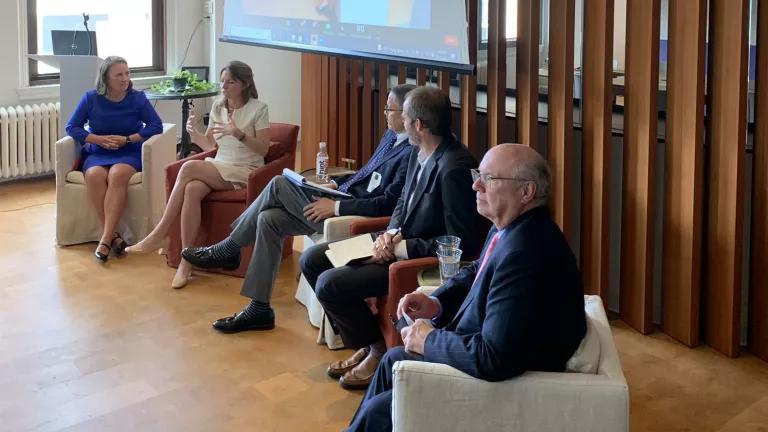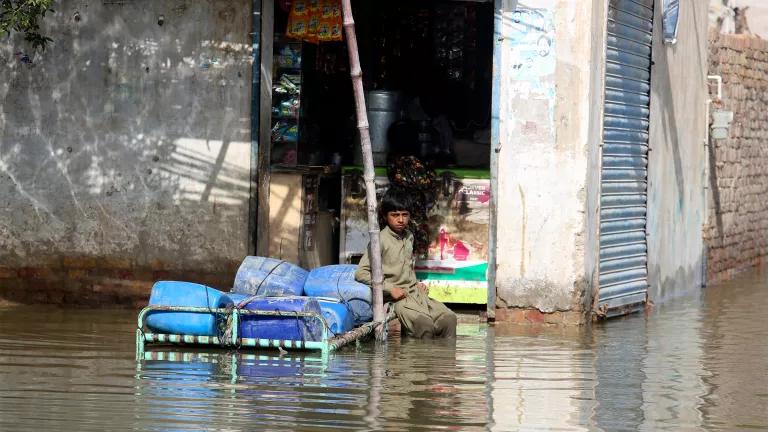Green Banking at Scale: Supercharging Climate Action
The new U.S. climate law will make substantial investments through its Greenhouse Gas Reduction Fund.

Green Bank Network member panel with green banks from New York, Connecticut, DC, and Rhode Island
As world leaders and other stakeholders convened in New York City for Climate Week, and the city bustled with the excitement of the climate law’s recent passage, it was important to remember the role of green banks and other institutions that will do the work on the ground that ensures the goals of the new law are achieved and the U.S. meets its climate targets.
The climate law, formally titled the Inflation Reduction Act, will make substantial investments through its Greenhouse Gas Reduction Fund. To make sure the funding has the desired impact, it is paramount to identify the right institutions to distribute these public funds and the best organizations for them to partner with. This is where green banks can help. Green banks fill a crucial need in the market by providing low-cost capital and innovative funding structures that help finance the development of technologies and infrastructure to address the climate challenge.
During Climate Week, NRDC and the Green Bank Network (GBN) hosted an event that featured keynote remarks by Senator Ed Markey and Representative Debbie Dingell, two long-time supporters of a U.S. national green bank that can leverage public and private funds to invest in clean energy and infrastructure. The event highlighted the potential impact of the climate law’s Greenhouse Gas Reduction Fund in spurring investment in disadvantaged communities and expanding nascent green sectors that are necessary to meet our climate goals. It also spotlighted the success of local green banks in utilizing public dollars to leverage private investment in projects that drive economic growth, improve the health and wellbeing of local communities, and reduce greenhouse gas emissions, including in low-income and marginalized communities.
Historic Climate Action to Meet Environmental Justice Goals
The two keynote speakers discussed the Inflation Reduction Act, which is projected to cut greenhouse gas pollution by as much as 41 percent below 2005 levels by 2030. The new law allocates $27 billion to establish the Greenhouse Gas Reduction Fund, over half of which is dedicated to advancing clean energy, resilient infrastructure, and energy efficient buildings in low-income and disadvantaged communities.
Representative Dingell highlighted that this fund and the IRA more broadly marks the “single largest investment in clean energy, environmental justice, and climate action in American history.” Senator Markey noted that the new Fund enables the establishment of a national climate bank, which would “make the United States a world leader in combating the causes and effects of climate change and maximize greenhouse gas emissions reduction per public dollar deployed.” Markey described his vision for a national climate bank with the capability to “rapidly deploy mature technologies while commercializing and scaling new technologies and make investments directly into projects that reduce emissions, as well as provide financing and technical assistance to eligible regional state and local green banks.”
Green Banks Driving Climate Action in Their Local Communities
To understand the impact that these funds may have on our economy and communities, we can look at how existing green banks in the U.S. have been using public funds to advance investment in clean energy and other green sectors. The new Greenhouse Gas Reduction Fund has the potential to help green banks (as well as Community Development Financial Institutions, minority depository institutions, and other community-based lenders like credit unions) greatly expand their ability to fulfill their green mandates and leverage private investment, particularly in underserved communities. Participants in the event highlighted some ways their institutions are working with local developers and entrepreneurs to spur green investment in local communities.
- Gregory Randolph, managing director at NY Green Bank (NYGB), described how the green bank helped scale Ecosave, a company providing deep energy retrofits, renewable energy generation, and energy storage services that reduce carbon emissions in the built environment. Ecosave CEO, Marcelo Rouco, explained the company needed access to a financing facility that was considered too small for big banks and too large for community lenders. NYGB stepped in to fill this gap by providing an innovative deal structure that enabled Ecosave to expand its operations in the state and beyond. Importantly the green bank will be able to replicate the model to help grow other small and medium businesses offering clean energy services.
- DC Green Bank (DCGB) has a facility to support solar in low-income housing that is not tied to credit, helping to expand access to clean energy. The green bank also works to build the capacity of local entrepreneurs and developers who want to make an impact in the green space but may lack sufficient audited financial history to obtain funding from traditional sources, explained DCGB CEO Eli Hopper. This focus on growing local businesses benefits both the climate and local economy.
- Projects implemented by Rhode Island Infrastructure Bank have saved roughly $140 million dollars in reduced energy costs for small businesses and municipalities across Rhode Island. That money improves the bottom line of local small business and non-profits and enables municipalities to deploy tax-payer funds into other priorities. One project Jeffrey Diehl, CEO of RIIB, described provided energy retrofit to a local school in a disadvantaged community, saving the district $150,000 in energy costs every year that the school board could then dedicate to other priorities such as teachers and other school improvements.
- Connecticut Green Bank (CGB) developed a working relation as a lender for Posigen Solar as part of their Solar For All Program to provide solar installation for low-income communities across Connecticut. According to Bert Hunter, executive vice president and CIO of CGB, this transformed Connecticut from a state where most solar energy was benefiting higher income residents to a state which now has an equal or slightly higher rate of solar energy among low-income communities than medium-high income communities.
Implementation to Advance Environmental Justice Is Key
The dollars provided by the new climate law bring an important level of policy stability and direction. Sarah Davidson, director of strategy, impact, and investor relations at the NY Green Bank, highlighted that the deployment of hundreds of billions of dollars into clean energy infrastructure in the U.S would send a strong signal to the market (and the world) after years of inconsistent climate policy. By providing federal funding to support climate action in disadvantaged communities, the new law can lead to “super-charged activity” over the next few years and new private investment in climate infrastructure that meets both emissions reduction and environmental equity goals. This will help advance projects such as community solar for low-income communities, as well as expand green bank activities into new program areas such as electric vehicles.
To ensure the Greenhouse Gas Fund is appropriately implemented, it is critical to clearly define which communities are eligible to benefit, prioritize racial equity, and align with existing complementary federal programs. With the right implementation and by scaling the capacity of local green banks, as well as other long-standing institutions like Community Development Financial Institutions, credit unions, and minority depository institutions, the Greenhouse Gas Reduction Fund can help provide low-income and disadvantaged communities with flexible, adaptive capital with good terms, education and technical assistance, and targeted and equitable projects that respond to community priorities.
At NRDC, we’ll continue to work with diverse partners and coalitions to help ensure the success of the new Greenhouse Gas Reduction Fund in advancing climate action and environmental justice.
This blog was written with Peter Trousdale, a consultant with NRDC’s Green Finance Center. His work focuses on expanding the green bank model through capacity-building programs such as the Green Bank Network (GBN). He previously worked with the Climate Finance team in NRDC’s Beijing office.




